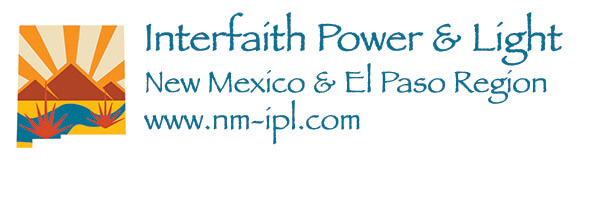NMIPL IN THE NEWS
Carlsbad Current Argus. Sep. 3, 2020 New Mexico finalizes oil and gas wastewater regulations, lawmakers hear testimony (Rev. Nick King Quoted)
Las Cruces Sun-News, Aug. 19, 2020, Report on solving climate crisis brings hope (Co-authored by Michael Sells, Clara Sims and Edith Yanez)
Santa Fe New Mexican, Aug. 15, 2020 Vote your values this November (Commentary by Larry Rasmussen and Tabitha Arnold)

Video: New Mexicans Experiencing Climate Change (Part 1)
/in Campaigns, Featured Articles, Media, NEWS /by adminThe first chapter of the Open New Doors video series, “Open New Doors to a Thriving New Mexico,” shares stories from community members experiencing climate change and fossil fuel pollution across New Mexico and their solutions and visions for the future. Their experiences show us that now is the time to open new doors to a thriving and resilient climate and economy for all New Mexicans. Video produced by Climate Advocates Voces Unidas.
Joan Brown Op-Ed: EPA should ensure methane protections
/in Featured Articles, Media, NEWS, NMIPL in the News, Permian Basin /by admin(Here is an opinion piece by Sister Joan Brown, osf, executive director of Interfaith Power & Light, New Mexico and El Paso. The piece was published in the Albuquerque Journal, on Sunday, January 29)
EPA should ensure methane protections
Pollutants cause health problems for people who keep the industry prosperous
BY JOAN BROWN ALBUQUERQUE
I’ve been working with families on the front lines of oil and gas production in the Permian Basin for the last 10 years. I’ve experienced first-hand growing concerns about health, quality of life, and environmental pollution.
Methane and other air pollutants from oil and gas drilling cause health conditions for the same people who keep the industry prosperous. That’s why I and many faith leaders in New Mexico joined hundreds of advocates from across the country in public hearings to urge the Environmental Protection Agency to swiftly finalize new protections that reduce methane pollution from oil and gas operations. There’s still time for the EPA to make changes to the rule and for New Mexicans and Texans to speak up for the strongest possible protections.
People of faith have been part of this fight from the start — we have a spiritual, ethical and moral duty to love and care for our neighbors. Right now, our neighbors are being impacted by methane pollution and climate change-fueled droughts and fires. I’ve met families in Jal who are very concerned. They need to work, but are living in fear for their children’s health and safety. Methane has more than 80 times the warming power of carbon dioxide over a 20-year period, making it a highly potent greenhouse gas. Reducing it would help address climate change by mitigating the natural disasters we’re already facing.
The concerns of a young woman I work with stay with me: “I do not know if I will have the strength to face all of the suffering that will result from climate change in my lifetime.” If we don’t act now, the burdens our youth are already bearing — grief, depression and hopelessness — will only worsen. It’s urgent that we strengthen and finalize these EPA rules to keep our young people safe.
While the EPA’s current proposal goes further than the initial draft, there are still a few key issues to address. Low-producing wells — that cause half of all site-level methane emissions in our country — must be checked regularly for leaks, along with wells with equipment, like storage tanks, that are known to malfunction. Currently, monitoring abandoned wells for leaks is not part of the rule, but if incorporated, would have a big impact on cutting methane. These changes will minimize damage to God’s creation and our communities.
New Mexico set a great example for states by eliminating routine venting and flaring, but those practices continue in Texas. Methane pollution from flares in Texas affects New Mexico, making it clear that state-level action isn’t enough. We need protections from the EPA to ensure that states work together to cut methane because we all share a common home. Our communities deserve to be part of this conversation, which can be done with participation in the Super Emitter Response Program that will monitor and address the industry’s largest leaks using public data.
Cutting methane isn’t optional — it’s a moral and ethical obligation that we have to each other, and we can stand together to let the EPA know that we need strong methane protections by submitting public comments before Feb. 13. Together with the EPA, resolute in our faith, we will address methane pollution and hold the oil and gas industry accountable.
Rally Urges Legislators, Governor to Protect Our Water
/in Faithful Citizenship, Featured Articles, NEWS, Water /by adminSeveral dozen advocates from diverse organizations (including New Mexico El Paso Interfaith Power & Light) joined the Middle Rio Grande Water Advocates (MRGWA) outside the Roundhouse on Thursday, January 26, to advocate for a proposed 2023 Water Security Planning Act.
“MRGWA and its allies are focused on encouraging legislators to work for us–the people– to pass important water legislation, and fund New Mexico’s water management agencies. The legislature and our Governor must increase our water agencies capacity to do the jobs they already have and address new challenges,” the organization said in its website.
“The Governor’s proposed budget includes substantial funds for water management and projects. That’s great! However, the Governor’s budget all but ignores the fact that our state water agencies do not have the capacity to productively spend it. We must persuade the Legislature to increase the capacity of our water agencies to proactively protect our water,” MRGWA added.
Read More